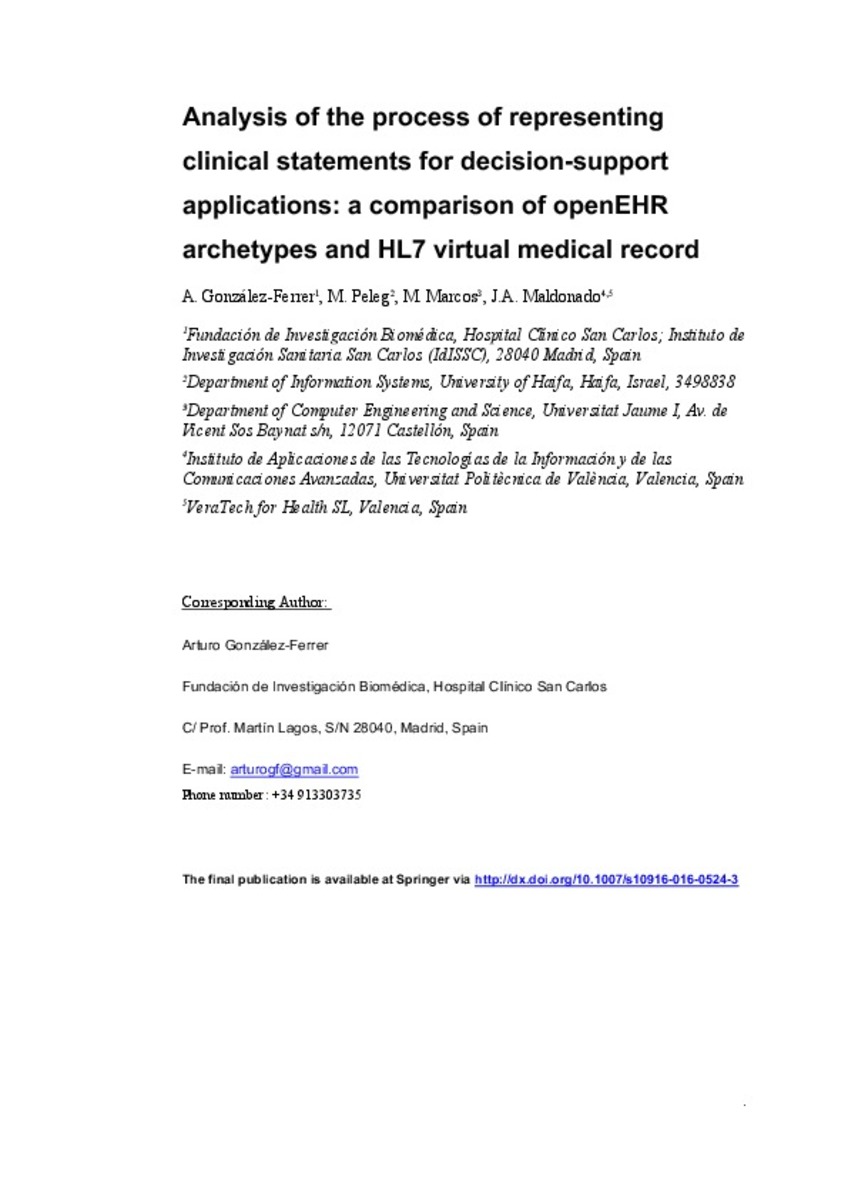Mostrar el registro sencillo del ítem
Analysis of the process of representing clinical statements for decision-support applications: a comparison of openEHR archetypes and HL7 virtual medical record
| dc.contributor.author | González-Ferrer, A. | |
| dc.contributor.author | Peleg, M. | |
| dc.contributor.author | Marcos, Mar | |
| dc.contributor.author | Maldonado, Jose Alberto | |
| dc.date.accessioned | 2016-09-13T11:42:48Z | |
| dc.date.available | 2016-09-13T11:42:48Z | |
| dc.date.issued | 2016 | |
| dc.identifier.citation | GONZÁLEZ-FERRER, A., et al. Analysis of the process of representing clinical statements for decision-support applications: a comparison of openEHR archetypes and HL7 virtual medical record. Journal of medical systems, 2016, vol. 40, no 7, p. 1-10. | ca_CA |
| dc.identifier.issn | 0148-5598 | |
| dc.identifier.issn | 1573-689X | |
| dc.identifier.uri | http://hdl.handle.net/10234/162463 | |
| dc.description.abstract | Delivering patient-specific decision-support based on computer-interpretable guidelines (CIGs) requires mapping CIG clinical statements (data items, clinical recommendations) into patients’ data. This is most effectively done via intermediate data schemas, which enable querying the data according to the semantics of a shared standard intermediate schema. This study aims to evaluate the use of HL7 virtual medical record (vMR) and openEHR archetypes as intermediate schemas for capturing clinical statements from CIGs that are mappable to electronic health records (EHRs) containing patient data and patient-specific recommendations. Using qualitative research methods, we analyzed the encoding of ten representative clinical statements taken from two CIGs used in real decision-support systems into two health information models (openEHR archetypes and HL7 vMR instances) by four experienced informaticians. Discussion among the modelers about each case study example greatly increased our understanding of the capabilities of these standards, which we share in this educational paper. Differing in content and structure, the openEHR archetypes were found to contain a greater level of representational detail and structure while the vMR representations took fewer steps to complete. The use of openEHR in the encoding of CIG clinical statements could potentially facilitate applications other than decision-support, including intelligent data analysis and integration of additional properties of data items from existing EHRs. On the other hand, due to their smaller size and fewer details, the use of vMR potentially supports quicker mapping of EHR data into clinical statements. | ca_CA |
| dc.description.sponsorShip | This study was partially funded by the European Commission 7th Framework Program, grant #287811. It has also been supported by the Spanish Ministry of Economy and Competitiveness and the EU FEDER programme through project TIN2014-53749-C2-1-R and grant PTQ-12-05620. | ca_CA |
| dc.format.extent | 10 p. | ca_CA |
| dc.format.mimetype | application/pdf | ca_CA |
| dc.language.iso | eng | ca_CA |
| dc.publisher | Springer | ca_CA |
| dc.relation.isFormatOf | Analysis of the process of representing clinical statements for decision-support applications: a comparison of openEHR archetypes and HL7 virtual medical record. Journal of medical systems, 2016, vol. 40, no 7 | ca_CA |
| dc.relation.isPartOf | Journal of medical systems, 2016, vol. 40, no 7 | ca_CA |
| dc.rights | © Springer International Publishing | ca_CA |
| dc.rights.uri | http://rightsstatements.org/vocab/InC/1.0/ | * |
| dc.subject | clinical guidelines | ca_CA |
| dc.subject | computer-interpretable guidelines | ca_CA |
| dc.subject | data integration | ca_CA |
| dc.subject | openEHR archetypes | ca_CA |
| dc.subject | HL7 virtual Medical Record (vMR) | ca_CA |
| dc.subject | clinical decision-support systems | ca_CA |
| dc.title | Analysis of the process of representing clinical statements for decision-support applications: a comparison of openEHR archetypes and HL7 virtual medical record | ca_CA |
| dc.type | info:eu-repo/semantics/article | ca_CA |
| dc.identifier.doi | http://dx.doi.org/10.1007/s10916-016-0524-3 | |
| dc.rights.accessRights | info:eu-repo/semantics/openAccess | ca_CA |
| dc.relation.publisherVersion | http://link.springer.com/article/10.1007%2Fs10916-016-0524-3 | ca_CA |
Ficheros en el ítem
Este ítem aparece en la(s) siguiente(s) colección(ones)
-
ICC_Articles [413]







